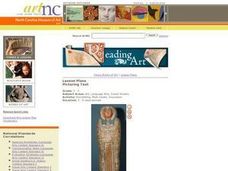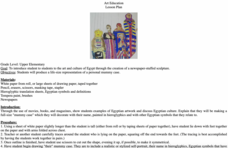Curated OER
Hieroglyphic Art Project
Students translate words and ideas into pictures. They make a list of words or phrases that could be drawn as symbols. Students complete this as part of a project on Egyptian and other civilizations that used hieroglyphics. They use...
Curated OER
Egyptian Cartouche
Sixth graders demonstrate their knowledge of Earth clay construction by creating, inscribing, and glazing an earth clay Egyptian cartouche. The lesson plan culminates with learners sharing their knowledge of key terms in the lesson plan...
Curated OER
Picturing Text
Students, through observation and discussion about the Coffin of Djed Mut, make connections between hieroglyphs and the English writing system. They create their own visual story using symbols that represent words.
Curated OER
Egyptian Mummy Cases
Here is an activity I'd like to do with my class! They researching the ins and outs of Egyptian culture, hieroglyphs, symbolism, and art, then use what they know to create realistic or stylized Mummy cases. These cases need to include...
Curated OER
King Tut On The Move
Students read a story called King Tut On the Move and answer vocabulary and comprehension questions about it. In this current events King Tut lesson plan, students respond to literature by answering questions, recalling details, sharing...
Curated OER
Home Hieroglyphics
Students explore the Egyptian hieroglyphics from cartouches listed in books or on the internet. They design a cartouche-shaped door knob door sign that contains hieroglyphics, meaning "keep out." They press the words into their cartouche...
Curated OER
Egyptian Relic: Ceramics Lesson
Egyptian artwork is inspiring in so many ways. Learners discover the world of Egyptian relics as they make a ceramic version of their own. Multiple resource links and full instructions make this a fun and easy-to-incorporate art project...
Curated OER
Egyptian Scarab Lesson Plan
Students explore scarabs of ancient Egypt. In this visual arts lesson, students discover the design and functionality of Egyptian scarab amulets. Students make their scarabs out clay that are etched with personal meanings.
Curated OER
Mesoamerican Carving Project
Third graders are introduced to the use of glyphs and relief carving by Mesoamerican cultures. They complete worksheets, view PowerPoint presentations, participate in a Webquest and create an original glyph carving in sandstone.
Curated OER
Clay Cartouche
A cartouche is an ancient Egyptian artifact containing the name of an important person or god. Included here are the instructions for creating cartouches out of clay. The class will use hieroglyphics and metallic paint to make these...
Curated OER
Egyptian Scarab Lesson Plan
Students investigate and create an Egyptian scarab. In this Egyptian art lesson, students analyze and discuss the Egyptian scarab. Students use Sculpey clay to create their own scarabs.
Curated OER
The Nile: A Gift to Egypt
Sixth graders discover the Egyptian culture. For this Nile River lesson, 6th graders examine why the river is so important to Egypt.Students study the religions, geography and the people of Egypt. Students create an exhibit where they...
Curated OER
Symmetrical Mummy Drawings/Mixed Media
Second graders explore Egyptian culture, including mummification, and hieroglyphic writings. They create their own mummy case using paper and a variety of materials. Students use symmetry to create their mummy.
Curated OER
Draw Like an Egyptian
Learners discover the cultural history of Egypt by illustrating Egyptian figures. In this art history lesson, students analyze the Egyptian styles of figure drawings and emulate that by creating their own illustrations using an Egyptian...
Curated OER
Art and Movement
Students analyze the art of movement and photographic techniques. In this art analysis lesson, students explore artistic techniques for communicating motion. Students complete image based discussion. Students make two drawings that...
Curated OER
American Residential Architecture
The students are introduced to the architecture of the metropolitan Richmond, Va. area. We look at and discuss quoins, architraves, fan lights, and many other aspects of architecture and their origins. The students design a house of...
Curated OER
Egyptian Profile Portraits
Second graders design Egyptian style portraits. They use the correct proportions while drawing and painting the facial features.
Curated OER
Draw Like an Egyptian
Second graders explore Egyptian life and art and examine Egyptian figures and translate them to their own artwork. Students use objects other than paint brushes to paint. Students practice using watercolors and practice figure proportions.
Curated OER
Sport as Social Ritual
Students become familiar with the sport that became a social ritual in ancient American cultures, examining its importance. They gain an understanding of how contemporary sports have acquired importance within modern American culture.
Curated OER
Master Spy
Students explain that a code is a system of symbols, letters, words, or signals that are used instead of ordinary words and numbers to send messages or to store information. They practice deciphering a variety of secret codes used in...
Curated OER
Signs of Everyday Life
Students examine how Keith Haring used signs in his artwork and explore signs in everyday life. They list the signs they see during the day, and invent a new way to sign their name as a tag or picture-sign.






















